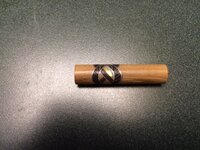LarryJB
Member
I made my 1st Celtic knot today and all was going well till I had a blow out!
I am just learning how to do all the pen turning thing and I am not going to be entering any contests or selling these. I have 2 big questions.
1) Is there anyway to fix this one? some of my ideas are:
a: color the brass tube with a sharpie and then fill in with CA glue? or Epoxy?
b: mix up saw dust and CA glue? or epoxy and fill in with that.
I figure I can mount the clip so that it covers the patch. This does not have to be perfect. I just want to somehow salvage it.
2) What can I do to prevent this from happening on the next one? Here are some of my thoughts.
a: make sure my chisels are sharp. I think the alum. dulled them. Maybe sharpen during the turning of each blank.
b: use skew instead of gouge. I usually start with the gouge and then finish with the skew. the blowout happened while using the gouge.
c: Increase rpms. It was at it slowest speed when this happened. I read somewhere that you should run slow until the blank is round, then increase speed. This was my plan, but forgot to increase the speed after I got it round.
d: I used epoxy to glue in the segments and alum. I then let it cure overnight before drilling. I used 5min epoxy to glue in the tube and waited about 45min before turning. Should I have waited longer before turning?
Any help would be greatly appreciated!
Thanks!
I am just learning how to do all the pen turning thing and I am not going to be entering any contests or selling these. I have 2 big questions.
1) Is there anyway to fix this one? some of my ideas are:
a: color the brass tube with a sharpie and then fill in with CA glue? or Epoxy?
b: mix up saw dust and CA glue? or epoxy and fill in with that.
I figure I can mount the clip so that it covers the patch. This does not have to be perfect. I just want to somehow salvage it.
2) What can I do to prevent this from happening on the next one? Here are some of my thoughts.
a: make sure my chisels are sharp. I think the alum. dulled them. Maybe sharpen during the turning of each blank.
b: use skew instead of gouge. I usually start with the gouge and then finish with the skew. the blowout happened while using the gouge.
c: Increase rpms. It was at it slowest speed when this happened. I read somewhere that you should run slow until the blank is round, then increase speed. This was my plan, but forgot to increase the speed after I got it round.
d: I used epoxy to glue in the segments and alum. I then let it cure overnight before drilling. I used 5min epoxy to glue in the tube and waited about 45min before turning. Should I have waited longer before turning?
Any help would be greatly appreciated!
Thanks!
Attachments
Last edited:

